Al-Hussein Mosque: A Sacred Landmark in Islamic Cairo
One of the most sacred religious and historical sites in Egypt is Al-Hussein Mosque located in the core of Islamic Cairo. Al-Hussein Mosque is traditionally believed to house the head of Imam Hussein, the grandson of Prophet Muhammad, although historical accounts vary and this remains a matter of religious belief. This sacred site is both a place of worship and a popular tourist attraction. Al-Hussein Mosque is one of the most beautiful mosques in the world with a rich spiritual heritage of Egyptian Islam. The mosque is a truly culturally rich experience regardless of whether you are a visitor because you are on a prayer trip or because you are on a historical trip
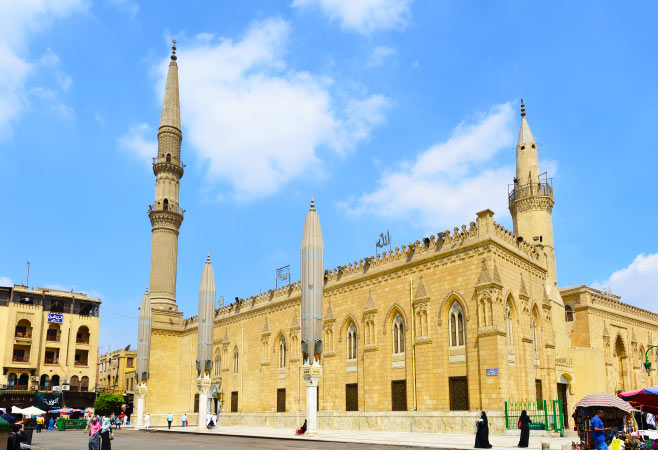
Discover more about Al-Hussein Mosque
Overview of Al Hussein Mosque
Al-Hussein Mosque is a historic and spiritual landmark in Cairo, known for its deep religious significance and Islamic architecture.
Location
Al-Hussein Mosque stands in the core of the Islamic Cairo, that is, in Hussein Square district, close to the long-established Khan El Khalili Bazaar. The mosque is only a few steps away from the downtown Cairo which is surrounded by vibrant Egyptian life with its ancient landmarks, busy souks and traditional Egyptian cafes. It is one of the most culturally rich and spiritually significant landmarks in Cairo, attracting both pilgrims and tourists worldwide and is the must-visit location by pilgrims, tourists, and every individual who chooses to begin with the spiritual and historical center of Cairo.
Entrance fee and open hours
Al-Hussein Mosque is mainly a place of worship but it has also become a generally tourist attraction place to go to its visitors who are in search of some history, spirituality and the beautiful Islamic architecture. Before your visit here are things you need to make note of:
- Entrance to Al-Hussein Mosque is free, but non-Muslim visitors may be restricted from entering certain inner prayer areas or the shrine section. The mosque is open to everyone as a spiritual sanctuary, regardless of financial status.
- The mosque is generally open from early morning until late evening, though opening times may vary depending on prayer schedules and maintenance. It’s advisable to visit outside major prayer times for easier access.
- Days open: Seven days a week, including weekends and public holidays.
- Best time to visit: Friday, the Islamic holy day, offers the most vibrant spiritual atmosphere.
Who is Al Hussein
Al-Hussein ibn Ali was the grandson of Prophet Muhammad. He plays a major role in Islamic history and even the history of Shia Islam. Having become the so-called Leader of the Youth of Paradise, he represented justice under the reign of the Umayyad. In 680 AD he was killed in the battle of Karbala, when he refused to bend his knees to Yazid. Ashura is the day commemorating his death particularly by Shia Muslims. The legacy of Al Hussein is the symbol of the fight with domination, which is one of the most valued sacrifices in Islamic culture.
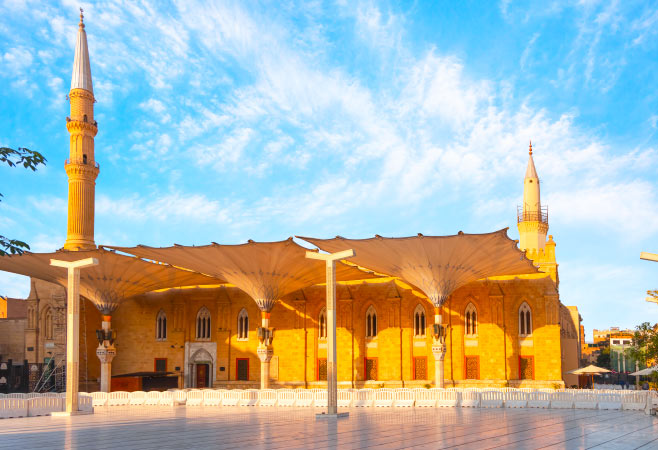
Al-Hussein ibn Ali
If you're looking to explore more architectural gems, don't miss this guide to the most beautiful mosque in Egypt, a testament to the country’s rich Islamic heritage.
History of Al-Hussein Mosque Cairo
Al-Hussein Mosque, which is in Cairo-Islamic region, is one of the most sacred Islamic spots in Egypt and a religious heritage to be proud of. The mosque is a Fatimid construction that was constructed around 1154 and some of the best Fatimid features are represented in the mosque. According to some Islamic traditions, the mosque is believed to house the head of Imam Hussein who was the grandson of Prophet Muhammad making it a major pilgrimage site to the Muslims of the whole world.
Some historical accounts claim that the head of Imam Hussein was discovered in Palestine, which led the Fatimids to build a shrine in Cairo. In 1237 it was refurbished with the help of the Ayyubid period and then was burned in 1248. The minaret at Bal al-Akhdar Gate is left over from this epoch.
Since the contemporary history, the mosque was severely renovated, and its significant restoration was made in 1996 because of the water damage. A new shrine dome was erected and in March 2022 the new shrine building was unveiled, making it look and feel more spiritual.
However, even the Fatimids credit the beginning of Al-Hussein Mosque to its very conception (along with numerous further examples), as through the ages, the Mosque has been undergoing the process of continuous and repeated restorations, and, thus, the Mosque is seen as a living symbol of the Islamic heritage of Cairo, its architectural masterpiece, and its spiritual meaning.
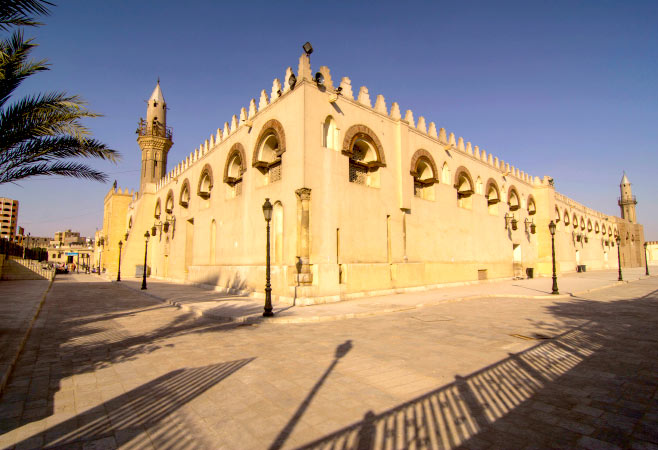
The historical background of Imam Hussein Mosque
For another fascinating example of Cairo’s religious and architectural grandeur, the Al Rifai mosque Egypt offers a unique blend of history, royal tombs, and ornate design.
Architecture of Al Hussein Mosque
Al-Hussein Mosque has a magnificent architectural style, which combines Fatimid, Ayyubid and Khedival designs pointing to hundreds of years of development in Islamic architecture. The mosque was originally constructed during the Fatimid period but significantly altered with time. Markedly, its south doorway still presents some of the best original decoration; an outstanding minaret of 1237 forms a remnant of Ayyubid overbuilding.
Isma il Pasha undertook a major overhaul in 1874 in revival of the Gothic style by mixing Ottoman and Italian Gothic styles. This brought Islamic eclecticism to the mosque, which points out to the various influences of the Khedival era in Egypt.
The special contemporary aspect is three oversized Teflon/steel umbrellas, which are mechanically operated to offer shade to the worshipers. This innovation is a reflection of designs observed in the leading Saudi mosques and provides additional comfort to the spiritual life.
The mosque has a large courtyard, graceful minarets and beautiful floral decorations on the prayer hall adorned with beautiful Islamic geometric patterns. This building is decorated with some calligraphy, tilework, and carved wooden panels and its roof is crowned with a central dome.
The Al-Hussein Mosque has been used as a worship place and historical site ever since. With its rich architecture and spiritual values, it is one place you have to visit to enter Cairo as a pilgrim, a tourist, or even an architecture aficionado.
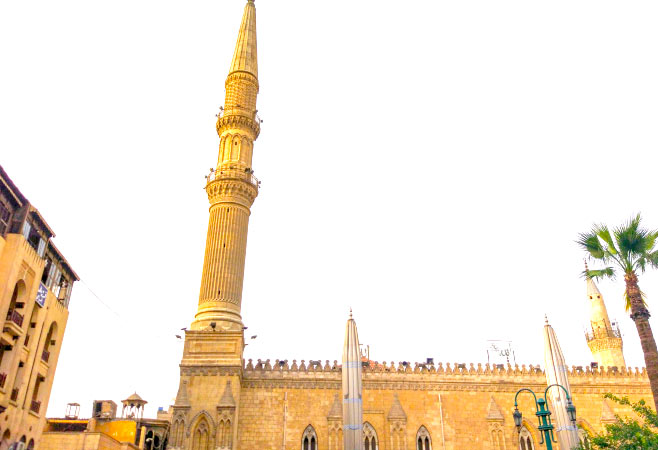
Structural beauty of Al Hussein Mosque
Just a short distance away, the Al Azhar mosque in Cairo Egypt stands as a cornerstone of Islamic scholarship and one of the oldest universities in the world.
Reason to visit Al Hussein Mosque Egypt
A trip to Al Hussein Mosque in Cairo is a life enriching experience which can be achieved through cultural, historical and spiritual aspects. Being one of the most sacred Islamic places in Egypt, the mosque will amaze its visitors by its calm atmosphere and pleasing architecture which is worth visiting by tourists and pilgrims.
The mosque is not only a place of worship but also a suitable cultural center. Local people are very friendly and they tend to talk to you or tourists and share some stories, traditions and in some cases they ask tourists to attend or sometimes participate in some traditional prayer ceremony. These are real life experiences and provide real insight in the spiritual and cultural life of Cairo.
The mosque is situated in the very heart of the Islamic Cairo and is literally a stone's throw from some other famous attractions including Khan El Khalili bazaar, Cairo Citadel, and Muhammad Ali Mosque. This enhances the ease to visit a number of historical sites within a day.
Al Hussein Mosque is a quiet place of reflection and peace even to the non religious visitor. Spiritual power and building aestheticism develop a special environment that facilitates being in the present moment and connectedness.
Being interested in Islamic heritage, local culture, or even in need of a peaceful location, Al Hussein Mosque is a place where every traveler can enjoy unforgettable experiences.
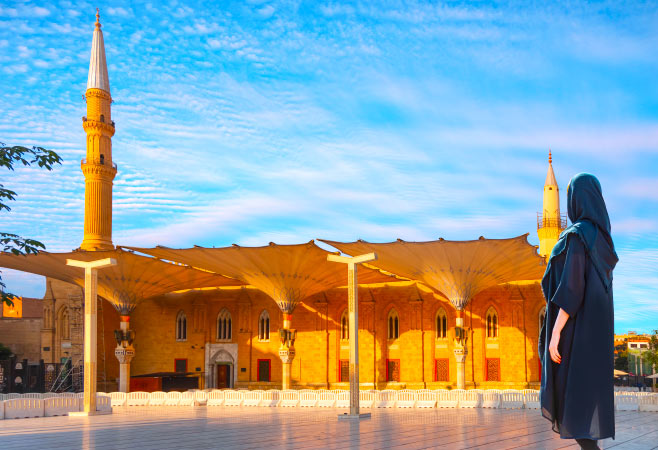
Top reasons to explore Al Hussein Mosque
To explore more of Cairo’s monumental Islamic architecture, don’t miss the mosque of Sultan Hassan Cairo, renowned for its massive scale and stunning Mamluk design.
How to get there
Reaching Al Hussein Mosque in Cairo is easy, with several convenient transportation options based on your location:
From the Great Pyramids of Giza: Take a taxi directly from the pyramids. It’s quick, convenient, and widely available.
From Cairo Tower:
- Take a local bus for a budget-friendly ride and experience the local atmosphere.
- Or walk to the mosque — it’s a pleasant stroll through city streets (wear comfortable shoes and stay hydrated).
From Luxor or Abu Simbel, you must travel to Cairo first by flight or train, then take local transportation to Al-Hussein Mosque. Walking to the mosque is only feasible if you’re already in Cairo city center.
Whichever option you choose, visiting El Hussein Mosque offers an unforgettable journey through Egypt’s culture and history.
For a journey further back in time, the mosque of Ibn Tulun offers a remarkable glimpse into early Islamic architecture with its unique design and historical depth.
Tips for visiting the Al Hussein Mosque
Visiting Al Hussein Mosque in Cairo is a rewarding cultural and spiritual experience. To make the most of your visit, keep these important tips in mind:
- Dress conservatively: Women and men are expected to dress in a modest way. It is recommended that women should cover their shoulders, arms, knees and even their head. Men ought not to wear shorts and sleeveless sweaters.
- The act of removing shoes: Shoes should be removed before entering the mosque. Use slip-on shoes to be convenient.
- Respect the space: Maintain a quiet and respectful attitude. Keep away disruption or loud speech, telephone, or phone conversations within the mosque.
- Photography ethics: permission must be sought prior to taking photographs especially when people are praying. In others there might be no photography allowed at all.
- Travel in the day: Day time is safer and livelier, more crowded and able to investigate with easier lighting.
- Fridays are the busiest and most spiritually significant day at the mosque. If you prefer a quieter visit, avoid peak prayer times around noon. However, visiting on Friday can be a fascinating experience to witness the vibrant religious atmosphere.
- Take a tour guide: It helps to know more about the history and the architecture of the mosque through local guides that will make the experience better.
- Ride safely: Wait for a licensed taxi or an app. Avoid unmarked vehicles.
With these tips, your visit to Al Hussein Mosque will be respectful, insightful, and memorable.
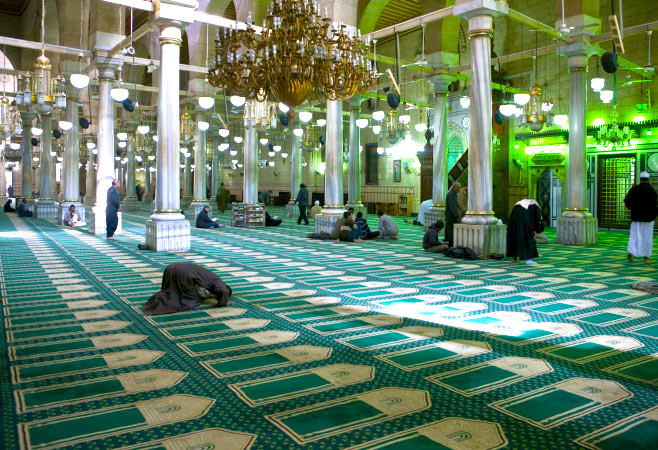
What to know before visiting Al Hussein Mosque
FAQs about Al-Hussein Mosque Cairo
What is significant about the Al-Hussein Mosque in Cairo?
The Al-Hussein Mosque is significant for housing what is believed to be the head of Imam Hussein, the grandson of Prophet Muhammad. Built in 1154, it is a major pilgrimage site and an iconic example of Islamic architecture, symbolizing Egypt’s deep religious and cultural heritage.
Who is buried in Al-Hussein Mosque?
Al-Hussein Mosque is believed to house the head of Imam Hussein, the grandson of Prophet Muhammad. While his body is buried in Karbala, Iraq, many Islamic traditions hold that his head was brought to Cairo, making the mosque a significant site of pilgrimage and reverence.
Is the mosque open to non-Muslim visitors?
Yes, Al-Hussein Mosque is open to non-Muslim visitors. Tourists are welcome to explore its historical and architectural beauty, but must dress modestly and respect Islamic customs. Access to certain prayer areas may be restricted during worship times to maintain the sanctity of the space.
Is photography allowed inside the mosque?
Photography is generally allowed inside Al-Hussein Mosque; however, visitors should be respectful. Avoid taking photos during prayer times or of worshippers without permission. Some areas may have restrictions, so it’s best to ask mosque staff or guides before photographing religious spaces or private sections.
How can I get to Al-Hussein Mosque?
Al-Hussein Mosque is located in Islamic Cairo, near Khan El Khalili. You can reach it by taxi, ride-sharing apps, or public buses from major landmarks like the Pyramids or Cairo Tower. Guided tours are also available. The area is pedestrian-friendly, making walking a pleasant option nearby.
Are there any special events or festivals held at the mosque?
Yes, Al-Hussein Mosque hosts several important religious events, most notably the Moulid of Imam Hussein, commemorating his birth. This annual festival attracts thousands of pilgrims. The mosque is also a focal point during Ramadan, especially for night prayers and community gatherings in Islamic Cairo.
In conclusion
Al Hussein Mosque, located in Cairo, Egypt, is one of the places that Islamic heritage, history, and architectural tours of duty cannot miss. The mosque is enriching in terms of its design as well as spiritual appeal which is deeply moving and spiritually enriching for all visitors. It is well accessible and situated in the heart of Islamic Cairo along other historic attractions. Online registration of your Egypt e-visa by using the official web-site of Egypt Immigration Service before you go will make your trip convenient. It is easy, quick and convenient to foreign visitors.
Related Articles
- Business Visa Egypt – Requirements, Fees & How to Apply
- Student Visa Egypt Guide: Requirements, Fees & Process
- 5 Year Multiple Entry Visa Egypt: Full Guide & Updates
- How much is a visa from Nigeria to Egypt? Full cost guide
- Egypt Visa Extension: How to Apply, Requirements & Guide
- Egypt Transit Visa Guide: Requirements, Process & Tips











